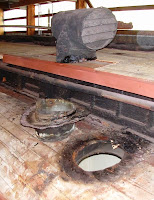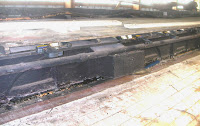But sometimes that's good, if black is what you want. Today was another busy day at IRM. Work on the 319 started with a finish coat of black on part of the lower roof, as seen here. The corner tack molding piece was removed so the back could be painted; it's sitting on top of the roof. Next, we'll need new curved tack molding pieces for the ends.

The new poplar pieces were bought yesterday, and here's the setup in my carefully-designed shop. The old pieces need to be clamped down to flatten them out for tracing, and we allow another inch or so on each end for trimming.
And once they're both traced out, it looks like this. The big bandsaw in the shop is the best tool to use for this job, but right now it's under repair; new guides are being made for it. Once it's in service, these pieces will be cut out and milled, and we'll be ready for intallation.
 The next pain in the derriére is the toilet ventilator. The only solution was to remove the cover inside the compartment, then bend down the tabs which had been bent up against the ceiling. Here we are looking up inside the little room. I should have taken a picture before I started, but here it is after the tabs were bent down.
The next pain in the derriére is the toilet ventilator. The only solution was to remove the cover inside the compartment, then bend down the tabs which had been bent up against the ceiling. Here we are looking up inside the little room. I should have taken a picture before I started, but here it is after the tabs were bent down.
Anyway, this is what it looks like after the lower part is finally pulled up. At least now we can stretch the canvas properly. As I said before, it's obvious why this wasn't done as part of the Trolleyville project. The ventilator itself could use some work, but I'm not sure it's worth the effort to clean off all the tar and paint.
Then at the east end of the car, I attached more of the additional pieces needed to hold the upper molding strips, and cut the molding pieces to length. They can be attached next time after the glue is dry. And I spent an hour or more removing tacks from the lower deck flashing. It's 1976 all over again.
If you ever want to build a PCC from scratch, we have just the plans you need. This blueprint is laid out in the shop as Eric and his friends put the Cleveland PCC back together.

And in other roof projects, the canvas on the Michigan Electric car and both of the lower sides of the 24 have been completely tacked down and are ready for paint. I guess we're just waiting for the temperatures to stabilize.
Today was the last day for the Trick or Treat Trolley and Terror on the Railroad, so if you've missed them, you're a chump. Happy Halloween nonetheless! We seemed to have a good number of visitors out today, and lots of other things were going on. The track gang were taking advantage of this opportunity to work on the steam leads, since the usual occupants are still out on the main. And so on. The next big thing to look forward to is the 60th Anniversary Gala Banquet on November 9th. You need to sign up by November 1st. Barb would be mad at me if I didn't mention this at every opportunity. And the consequences are too terrifying to contemplate.







2 comments:
The 'tar' is flax paint, right?
It seems like CA&E coated everything on roofs with that stuff, including horns, probably so they wouldn't have to take their time to paint around those things. It is ugly, but its the way CA&E did it. Unless Cleveland did it.
The "tar" had the trade name Liquinoleum and was an asphalt-based substance probably similar to the roof coatings you can still get today. I'm not a chemist so I can't be any more specific than that. If you heat it up, it turns into goo and will solidify again, and you can do this an indefinite number of times. It doesn't just burn up and flake off like paint. Wheaton started applying it about 1950, and by the end nearly every car had a roof covered with tar.
Post a Comment